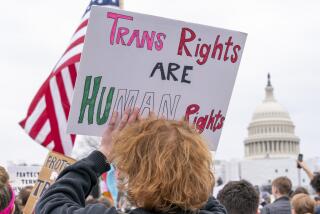High court hears cases on ban of abortion method
- Share via
WASHINGTON — A Bush administration lawyer urged the Supreme Court on Wednesday to uphold the nation’s first criminal ban on an abortion method, saying so-called partial-birth abortions are “too close to infanticide” and not a medical necessity.
Safe alternatives are always available, U.S. Solicitor General Paul D. Clement said in defending a law passed by Congress in 2003.
But two abortion-rights advocates argued that the ban, if put into effect, would unwisely limit the options of doctors who perform abortions in the second trimester and would expose some pregnant women to more dangerous surgery.
These doctors believe that the procedure medically known as dilation and extraction, or D&X; -- in which the fetus is removed intact -- “reduces the risk of serious complications,” including bleeding and infection in the uterus, said Priscilla Smith, a lawyer for the Center for Reproductive Rights in New York.
“What Congress has done here is take away from women the option of what may be the safest procedure for her,” said Eve Gartner, a lawyer for the Planned Parenthood Federation of America.
The case could prove a turning point for the Supreme Court on abortion. With the arrival of President Bush’s two conservative appointees, there appears to be a five-vote majority, including Justice Anthony M. Kennedy, to uphold stricter regulation of abortion.
Six years ago when the court struck down a Nebraska ban on the practice, Kennedy wrote an impassioned dissent, describing D&X; as “abhorrent.”
Abortion-rights advocates hope he will switch sides. But Wednesday, Kennedy suggested that the disputed procedure might be “purely elective and not medically necessary.”
New Justice Samuel A. Alito Jr. said nothing. But he and Chief Justice John G. Roberts Jr. have been counted as likely to uphold the federal Partial Birth Abortion Ban Act.
The measure, a proud achievement of Bush and the Republican-controlled Congress, coincidentally came before the court the day after its prime sponsor Sen. Rick Santorum (R-Pa.) went down to defeat and the GOP lost control of Congress.
Most of the two-hour argument Wednesday was about the scope of the law, which would ban a procedure used only after the 16th week of pregnancy. Critics call it “partial-birth” abortion because doctors extract the living fetus partway from the uterus, then collapse its skull before pulling the fetus the rest of the way out.
Minimizing the law’s impact, Clement described D&X; as a “very aberrant, atypical procedure” and said a ban would affect “a very small minority of second-trimester abortions.”
Most such abortions use “dilation and evacuation,” or D&E;, in which the fetus is dismembered in the uterus before it is removed.
Moreover, a doctor who planned to remove the fetus intact could “induce fetal demise at the outset” -- injecting it with a drug to stop its heart -- without violating the law, Clement said, because the fetus would emerge dead.
Some medical experts, however, say such injections pose too great a risk of exposing the woman to a deadly chemical.
Even if the law is upheld, Clement said, doctors can go to court and ask for an exception that “focuses on particular medical conditions” that call for the D&X; procedure.
Several liberal justices objected during the argument to talk of “infanticide.” They stressed that most second-trimester abortions involved fetuses that could not live on their own.
Some “are only 4 or 5 inches long. They are very different from fully formed babies,” Justice John Paul Stevens said.
“So anything about infanticide, babies, all that, is just beside the point because what this bans is a method of abortion,” added Justice Ruth Bader Ginsburg.
Clement refused to back down. Congress was interested in “maintaining a bright line between abortion and infanticide,” he said.
Once a fetus emerged alive from the uterus, if it were killed, “I think we’d call that murder,” he added.
The two lawyers arguing against the law sought to portray its reach as broad. They stressed that the ban does not use medical terms, such as D&X; or D&E.;
It could “place doctors at risk of prosecution” for D&E; abortions if they removed a large part of the fetus, said Gartner, Planned Parenthood’s lawyer. Rather than banning only one procedure, the law could ban the most common second-trimester procedure, she said.
Roberts disagreed. What counts is the doctor’s intent, he said. A doctor who intends to do a D&E; “wouldn’t be covered by this law,” he said.
Roberts conceded the D&X; procedure might have “a marginal impact on safety” for patients, but he questioned whether that should be enough to strike down the entire law.
Smith replied that medical experts said the issue went well beyond marginal benefits.
“The reduction in risk is significant,” she said, saying the D&X; method “reduces the risk of serious complications, such as uterine perforation, which ... lead to hysterectomies and infertility.”
After Congress passed the law, judges in San Francisco, New York and Omaha barred it from taking effect. The Supreme Court heard the government’s appeal in two cases Wednesday and will issue a ruling in several months.
*
More to Read
Sign up for Essential California
The most important California stories and recommendations in your inbox every morning.
You may occasionally receive promotional content from the Los Angeles Times.











